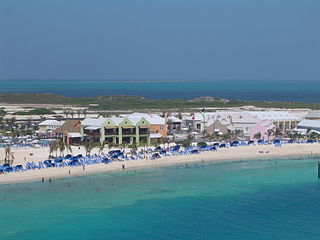![Turks and Caicos Islands dependent country in West Indies]]](https://upload.wikimedia.org/wikipedia/commons/thumb/a/a0/Flag_of_the_Turks_and_Caicos_Islands.svg/320px-Flag_of_the_Turks_and_Caicos_Islands.svg.png)
The Turks and Caicos Islands are a British Overseas Territory consisting of the larger Caicos Islands and smaller Turks Islands, two groups of tropical islands in the Lucayan Archipelago of the Atlantic Ocean and northern West Indies. They are known primarily for tourism and as an offshore financial centre. The resident population is 31,458 as of 2012 of whom 23,769 live on Providenciales in the Caicos Islands. It is the third largest of the British overseas territories by population.

Grand Turk Island is an island in the Turks and Caicos Islands. It is the largest island in the Turks Islands with 18 km2 (6.9 sq mi). Grand Turk contains the territory's capital, Cockburn Town and the JAGS McCartney International Airport. The island is the administrative, historic, cultural and financial center of the territory, and has the second largest population of the islands at approximately 3,720 people.

Mammillaria is one of the largest genera in the cactus family (Cactaceae), with currently 200 known species and varieties recognized. Most of the mammillarias are native to Mexico, but some come from the southwest United States, the Caribbean, Colombia, Venezuela, Guatemala and Honduras. The common name "pincushion cactus" refers to this and the closely related genus Escobaria.

Providenciales is an island in the northwest Caicos Islands, part of the Turks and Caicos Islands, a British Overseas Territory. The island has an area of 98 km2 (38 sq mi) and a 2012 Census population of 23,769. Providenciales is the largest island in population, the third largest in area, and is home to a large majority of the population of the Turks and Caicos Islands. Providenciales was ranked the best beach destination in the world by TripAdvisor in 2011.

The coat of arms of the Turks and Caicos Islands was granted in 1965.

Albert Glen "Turk" Edwards was an American football tackle in the National Football League (NFL). He played his entire career for the Washington Redskins, starting with their first six seasons in Boston, and later became the head coach. Edwards was inducted into the Pro Football Hall of Fame in 1969.
Turk's cap is a common name for several plants and may refer to:

Opuntia stricta is a large sized species of cactus that is endemic in the subtropical and tropical coastal areas of the Americas and the Caribbean. Common names include erect prickly pear and nopal estricto (Spanish). The first description as Cactus strictus was published in 1803 by Adrian Hardy Haworth. In 1812 he introduced the species in the genus Opuntia.

The cactus mouse is a species of rodent in the family Cricetidae. It is one species of a closely related group of common mice often called deer mice. Cactus mice are small, between 18 and 40 g in weight. Females weigh slightly more than males and are significantly larger in body length, ear length, length of mandible, and bullar width of skull. Cactus mice can be identified by having naked soles on their hind feet and almost naked tails, which are usually the same length or longer than the animals' body length. Their ears are nearly hairless, large, and membranous. Their fur is long and soft; coloration varies between subspecies and between different populations. Color of fur varies from ochre to cinnamon, with white ventral areas, and the sides and top of head slightly grayish. Females tend to be slightly paler in color than males, while juveniles appear more gray than their parents.

Ambergris Cay, also known as Big Ambergris Cay, is a private residential island located within the Turks and Caicos Islands. Not to be confused with Ambergris Caye in Belize, Ambergris Cay is situated to the southeast of the main chain of the Caicos islands. Adjacent to Ambergris Cay is Little Ambergris Cay, which is an uninhabited natural reserve. Little Ambergris Cay is a unique and significant habitat for a wide range of birds and marine life. Ambergris Cay island is approximately four miles long, one mile wide, and 1,100 acres (4.5 km2) in total.

Pilosocereus royenii is a species of cactus that is native to the Caribbean and Mexico's Yucatán Peninsula. Common names include Royen's tree cactus, dildo cactus and pipe organ cactus. It is the most common cactus found in the Turks and Caicos Islands. It is composed of multiple long, tubular shaped branches, each ribbed with multiple sections and sharp spines.
The Bahamian dry forests are a tropical and subtropical dry broadleaf forest ecoregion in the Bahamas and the Turks and Caicos Islands, covering an area of 4,800 km2 (1,900 sq mi). They are found on much of the northern Bahamas, including Andros, Abaco, and Grand Bahama, where they are known as coppices. Dry forests are distributed evenly throughout the Turks and Caicos.

Melocactus matanzanus, common name Dwarf Turk's-cap cactus or Turk's-cap cactus, is a cactus in the genus Melocactus belonging to the family Cactaceae. The epithet matanzanus is derived from the Cuban province of Matanzas.
Geronimo Park was a baseball park in Apache Junction, Arizona that was in use from 1962 until 1963. It lay vacant from 1963 until it was dismantled in 1969 after being sold to Mesa Public Schools. Its location is currently occupied by a lodge of the Loyal Order of Moose. With a view of Superstition Mountains, it was the first spring training ball park of the Houston Colt .45s.
This page is based on this
Wikipedia article Text is available under the
CC BY-SA 4.0 license; additional terms may apply.
Images, videos and audio are available under their respective licenses.






![Turks and Caicos Islands dependent country in West Indies]]](https://upload.wikimedia.org/wikipedia/commons/thumb/a/a0/Flag_of_the_Turks_and_Caicos_Islands.svg/320px-Flag_of_the_Turks_and_Caicos_Islands.svg.png)









